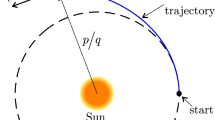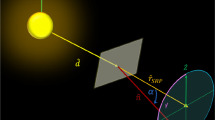Abstract
The optimization of an interstellar probe trajectory using solar sailing is investigated. With a single solar photonic assistance, solar sails can enable the sailcraft to gain high energy to escape the solar system with a cruise speed of greater than 10 AU/year. Based on a reasonable assumption of a jettison point at 5 AU, a new objective function with a variable scale parameter is adopted to solve the time optimal control problem using an indirect method. A technique of scaling of the adjoint variables is presented to make the optimization much easier than before. A comparison between the current results and previous studies has been conducted to show the advantages of the new objective function. In terms of the mission time, the influence of the departure point of the sailcraft from the Earth orbit is discussed without consideration of the Geo-centric escape phase. Another interesting discovery is that the angular momentum reversal trajectory is achieved as a local-optimal solution in a demonstration mission of 250 AU. Under the same initial condition, the difference between the direct and reversal flybys is discussed in detail through numerical simulations along with their advantages.




Similar content being viewed by others
References
Sauer Jr., C.G.: Solar Sail Trajectories for Solar-Polar and Interstellar Probe Missions. AAS 99–336, 1–16 (1999)
Mori, O., Tsuda, Y., Sawada, H., et al. “World's First Demonstration of Solar Power Sailing by IKAROS,” Second International Symposium on Solar Sailing (ISSS-2010), Brooklyn, NY, USA, 2010
McInnes, C.R.: Delivering Fast and Capable Missions to the Outer Solar System. Adv Space Res 34, 184–191 (2004)
Sauer, C.G., Jr. “Optimum Solar-Sail Interplanetary Trajectories,” AIAA Paper 76–792, 1976
Mengali, G., Quarta, A.A.: Optimal Three-Dimensional Interplanetary Rendezvous Using Nonideal Solar Sail. J Guid Control Dyn 28(1), 173–177 (2005)
Dachwald, B.: Optimal Solar-Sail Trajectories forMissions to the outer Solar System. J Guid Control Dyn 28(6), 1187–1193 (2005)
Macdonald, M., McInnes, C.R., Hughes, G.: Technology Requirements of Exploration Beyond Neptune by Solar Sail Propulsion”. J Spacecr Rocket 47(3), 472–483 (2010). doi:10.2514/1.46657
Vulpetti, G.: Sailcraft at High Speed by Orbital Angular Momentum Reversal. Acta Astronautica 40(10), 733–758 (1997)
Zeng, X.Y., Li, J.F., Baoyin, H.X., Gong, S.P. “Trajectory optimization and applications using high performance solar sails”. Theoretical & applied mechanics letters. V1(3): 033001, 1–7 (2011)
Rowe, W. M., Luedke, E. E., and Edwards, D. K. “Thermal Radiative Properties of Solar Sail Film Materials,” 2nd AIAA/ASME Thermophysics and Heat Transfer Conference, Palo Alto, California, USA, Paper AIAA 78–852, 1978
Leipold, M., Wagner, O.: Solar Photonic Assist Trajectory Design for Solar Sail Missions to the Outer Solar System and Beyond. Adv Astronaut Sci 100(2), 1035–1045 (1998)
Pontryagin, L. S., Boltyanskii, V. G., Gamkrelidze, R. V., Mishchenko, E. F. The Mathematical Theory of Optimal Processes, Authorized Translation from the Russian, Translator: Trirogoff, K. N., Editor: Neustadt, L.W., 1962
McInnes, C.R.: Solar Sailing: Technology, Dynamics and Mission Applications, pp. 115–151. Springer–Verlag, London (1999)
Lawden, D.F. Impulsive transfers between elliptical orbits. Optimization Techniques, Academic Press, 1962, Ch. 11, pp. 323–351
Jiang, F.H., Baoyin, H.X., Li, J.F.: Practical techniques for low-thrust trajectory optimization with homotopic approach. J Guid Control Dyn 35(1), 245–258 (2012)
Ross, I.M., Fahroo, F.: “Legendre Pseudospectral Approximations of Optimal Control Problems”, Lecture Notes in Control and Information Sciences. Springer–Verlag, New York (2003)
Benson, D. “A Gauss Pseudospectral Transcription for Optimal Control,” Ph.D. Thesis, Department of Aeronautics and Astronautics, MIT, 2004
Fahroo, F., Ross, I.M.: Direct Trajectory Optimization by a Chebyshev Pseudospectral Method. J Guid Control Dyn 25(1), 160–166 (2002)
Sharma, D.N., Scheeres, D.J.: Solar-System Escape Trajectories Using Solar Sails. J. Spacecr. Rocket. 41(4), 684–687 (2004)
Mengali, G., Quarta, A.A.: Rapid Solar Sail Rendezvous Missions to Asteroid 99942 Apophis. J. Spacecr. Rocket. 46(1), 134–140 (2009)
Lisano, M., Lawrence, D. Piggott, S. “Solar Sail Transfer Trajectory Design and Stationkeeping Control for Missions to the Sub-L1 Equilibrium Region,” Paper AAS 05–219, pp. 1–19, presented at 15th AAS/AIAA Spaceflight Mechanics Conference, Colorado, 2005
Macdonald, M., McInnes, C.R.: Analytic Control Laws for Near-Optimal Geocentric Solar Sail Transfers”. Adv Astronaut Sci 109(Pt. 3), 2393–2411 (2001)
Dachwald, B., Seboldt, W. “Solar Sailcraft of the First Generation - Mission Applications to Near-Earth Asteroids,” 54th International Astronautical Congress, Bremen, Germany (IAC-03-Q.5.06), 2003
Acknowledgments
This work was supported by the National Natural Science Foundation of China (Grants No.10832004). The first author would like to acknowledge the financial support provided by the China Scholarship Council, to be as a Visiting Ph.D. Student at the Department of Aerospace Engineering of Texas A&M University with TEES Research Chair Professor Kyle T. Alfriend.
Author information
Authors and Affiliations
Corresponding author
Additional information
Presented as Paper AAS 2012–234 at the AAS/AIAA 22th Space Flight Mechanics Meeting, Charleston, SC, Jan 29-Feb 02, 2012
Rights and permissions
About this article
Cite this article
Zeng, X., Alfriend, K.T., Li, J. et al. Optimal Solar Sail Trajectory Analysis for Interstellar Missions. J of Astronaut Sci 59, 502–516 (2012). https://doi.org/10.1007/s40295-014-0008-y
Published:
Issue Date:
DOI: https://doi.org/10.1007/s40295-014-0008-y




